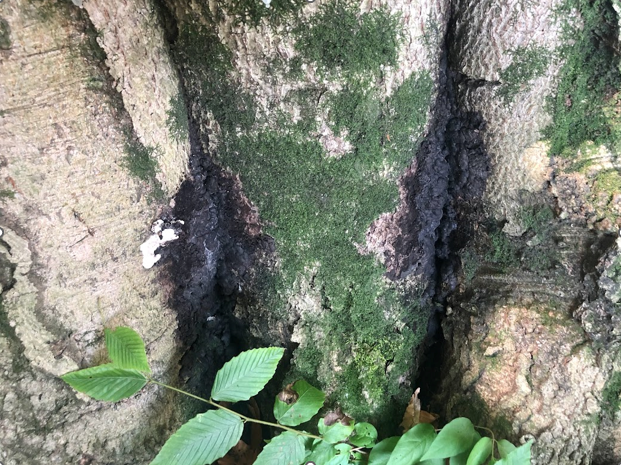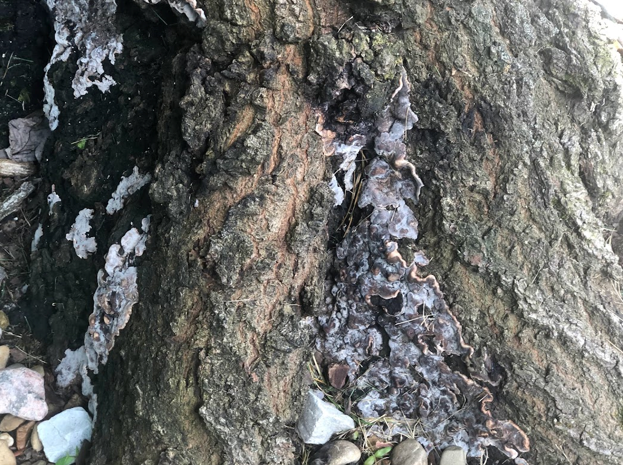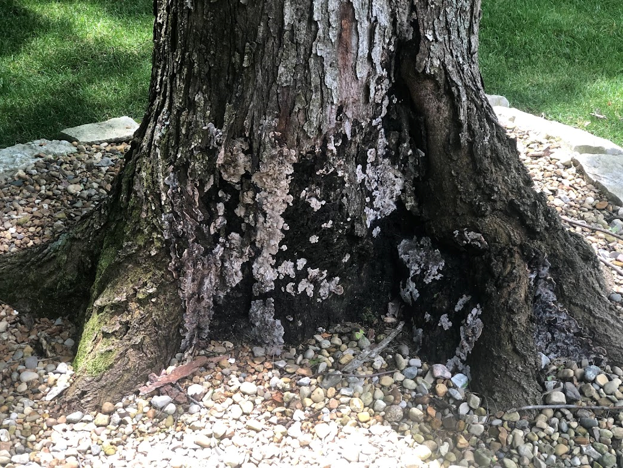Burnt Crust or Brittle Cinder Fungus, the silent killer

Recently I was called upon to inspect an apparently healthy American beech (Fagus grandifolia) tree. Outside of a few tightly bifurcated branch unions, the only real issue with this tree with a 43-inch trunk diameter was this black ooze at the tree base. This fungal infection is identified as the fungal pathogen Kretzschmaria deusta which is sometimes known as the burnt crust fungus or brittle cinder fungus.
Oddly, while I hear a lot about Ganoderma and Armillaria, I hear much less about Kretzschmaria deusta. My colleague Guy Meilleur refers to these three groups of fungal pathogens as the “big 3”, in other words the 3 most important and insidious fungal infections which cause decay in trees and can compromise them structurally.
Essentially, this is a cancer diagnosis, and a serious one, for the tree but as with cancer diagnoses in people, such infections can sometimes be managed if not too advanced. Unfortunately, despite management, this disease is ultimately fatal and there is no cure.

The University of Massachusetts Amherst says:
Kretzschmaria is a destructive root and trunk rot pathogen of deciduous hardwoods, decaying both lignin and cellulose. However, unlike many white rot fungi, cellulose is preferentially targeted during the decay process. As cellulose is decayed, the infected wood tissue rapidly loses strength. But due to the pattern of decay this fungus exhibits, the wood can still appear relatively sound. Infections can initiate in the roots and spread to the base, where the fungus causes a butt rot of the lower trunk. Additionally, Kretzschmaria can colonize basal wounds, which are common on landscape beech trees. Decaying wood appears bleached with distinct black zone lines intermixed in the decaying wood. Like most wood-rotting fungi, symptoms are often cryptic to non-existent. Undersized foliage, canopy dieback, basal cankers, sap flow and sloughing bark can develop as infections intensify. Bleeding cankers can also develop and may be confused with those caused by Phytophthora.
Nothing can be done to eradicate the pathogen once present since the fungus lives in roots and the heartwood. Boosting vigor and minimizing additional stresses are really the only management strategies for advanced wood rot infections. A basal bark application of phosphites may help to slow the progression of the disease into the sapwood and cambium but ultimately the tree will die as a result of the disease. Upon death, try to remove as much of the root material as possible. If the stump is left, the fungus will persist on site and may infect a newly planted tree nearby. Avoid replanting with beech or maple when the tree is removed.

The problem with this disease is that it comes with no obvious symptoms, other than the appearance of the fungal masses, little or no observable decline in tree health, and major loss of wood strength which is often not detectable with a tap test and may not be detectable with a Resistograph test or even sonic tomography.
The red maple in figures 2 and 3 is a 70-foot-tall tree growing in a formerly wooded area which was carved out for a housing development. The house is about 30 feet away. The tree, having grown and developed in the forest, is tall and somewhat skinny, although it has filled out some over the years. The tree canopy is apparently healthy with little dead wood and no apparent die back and yet the tree has this advanced infection at the base. The tree being as tall as it is and as close to the house (the target) as it is, that places this tree rather high in the risk categorization according to the International Society of Arboriculture Tree Risk Assessment Qualification protocol with basically no viable risk mitigation options except removal. I hate to see a tree removed but this one is liable to fall over otherwise.

